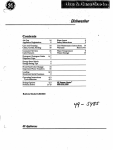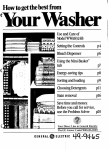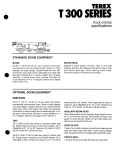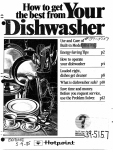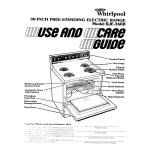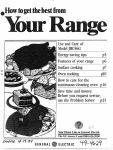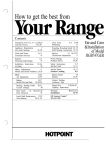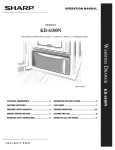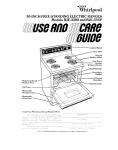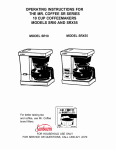Download MTD M2N-L Lawn Mower User Manual
Transcript
r
UseandCareof
Mi)delGSD2600D
Yourelectronic
touch-controls
p2
Opemtinginstructions
p2
Dishwashingshort-cut
p4
Loadedright,
dishesgetcleaner
p12
Whatisdishwashersafe? p 15
Savetimeandmoney
Beforeyoucallforservice,
usetheProblemSolver
p17
Your Direct Line to General Electric
The GE Answer CenteF800.626.2000
GENE RAL@EIECTRIC
.. . ....———
—.—.
.. .—
~-–---–-–’–---”---
“
-
Help us
help
you...
Read this book carefully
Write down the model and
serial numbers.
It is designed to help you operate
and maintain your new dishwasher
properly.
You’ll find them on a label on the
left side of the dishwasher just
inside the door.
Keep it handy for answers to your
questions.
These numbers are also on the
Consumer Product Ownership
Registration card that came with
your dishwasher. Before sending in
this card, please write these
numbers here:
If you don’t understand something
or need more help... Call, toll free:
The GE Answer CenterTM
800.626.2000
consumer information service
or write (include your phone
number]
Consumer Affairs
General Electric Company
Appliance Park
Louisville, KY 40225
What can you wash safely . . . . . 15
‘
Care of yourdishw’ksher . . . ....16
~
Problemsolving . . . . . . . ...17-19
:
Serial No.
Use these numbers in any
correspondence or service calls
concerning your dishwasher.
If you receive a damaged
dishwasher, immediately contact
the dealer (or builder) that sold you
the dishwasher.
Consumerservices . . . . . . . ...21
“
Model No.
Save time and money...
before you call for service
Warranty . . . . . . . . . .. BackCover
Check the Problem Solver (pages
17-19).It lists minor causes of
operating problems that you can
correct yourself. It could save you
an unnecessary service call.
Convenience Features
This is a very advanced, automatic
and versatile dishwasher. It’s very
easy to understand and use, but it
is different. Before using your
dishwasher the first time, read and
follow these instructions.
This dishwasher has many convenient features. Among them are:
. Controls are arranged left to
right as you use them.
. Automatic responses to instructions let you know the desired
function has been selected.
c Lets you select fast, heated
drying or energy-saving no-heat
drying.
. A SYSTEMS MONITOR that tells
you what’s happening in the
dishwasher and if something’s
wrong.
. Lets you LOCK the controls to
prevent accidental tampering.
. Remembers your last cycle so
you don’t have to re-program each
time. See SHORTCUT on page 4.
c:
-.
.
.,’
&.G&#.@,.g:*;+-**
+:
- ‘;
IMPORTANT SAFETY iNSTRUCTIOB& @%=
~
Read all instructions before using
this appliance~~?x:,
,.
.“.
.
. ‘2.’.”.
.
~‘+-
● This dishwashermust be
.~-”-;,’ ~%”,aT~~ge
properlyinstalled and locatedin +-.~$*~$*;g;:~:-” “‘“, o; :“”:
accordancewith the installation 4-T0 minimizmti”sw!lf~?ig%
Instructionsbefore it is used. If ~‘i;. of injury. :$
you did not receive an Installation
Instructions sheet with your
dishwasher you can obtain one by’
contacting the service location
.“
nearest you.
—This appliance must be “ - “‘~
connected to a grounded metal,
permanent, wiring system; or an
equipmentgrounding conductor
“
must be run with the circuit
conductors and connected to the
equipment-grounding terminal or
lead of the appliance.
~
G
~‘~ Connect to a properly rated,’
“protected and sized power-supply
circuit to avoid electrical overload.
Use only detergents or wetting
agents recommended for use in a
dishwasher.
●
. Do not wash plastic items unless
marked “dishwasher safe” or the
equivalent. For plastic items not so
;.*-?~:
~. they are not Ii
after use.
QDo not operate your dishwasher
unless all enclosure panels are
properly in place. “
Do not tamper with controls. “” -......
● Do not ‘abuse, sit on, or stand
on the door or dish rack of the
dishwasher.
●
● Close supervision
is necessary if
this appliance is used by or near
children. Do not allow children to
,.
Things to do before you
program your dishwasher
I
4
Q Load your dishwasher and add
detergent. See pages 10 through
14 for complete instructions on
loading.
TURN THE PAGE
“
for Programing Instructions
. Close the dishwasher door and
move the latch to the right to the
“ON” Dosition.
,.
1
.. -%
..
.“-”“/’‘:*
.
How to program vour dishwasher
m
w
w
SELECTED
CYCLE
INDICATOR
LIGHTS
DOOR IATCH
‘“OFF” POSITIC
.
2
1
-.
Select a wash cycle
Select a
Select a wash cycle that is most suited to the soil condltlon of your load. Touch the
center of the pad that describes your selection. Your cycle selections are:
drying option
c HEATED DRYING.
. POTSCRUBBER—
be included:
Provides faster drying. t
be changed while cycle
running.
For items such as pots, pans and casseroles.
Everyday dishes may
● NORMAL
WASH-For
loads of everyday dishes with medium SOIIS.Designed to yield
high performance on normal loads.
. LIGHT WASH— For tableware that is lightly soiled with fresh soils. Pre-rinse tableware. This cycle uses less hot water and energy than the previous cycle and can save
you time, too. If performance doesn’t meet your expectation, move up to one of the
higher performance cycles.
● ENERGY SAVER—For
most loads of everyday dishes with light soIls or soils that have
not dried on. It saves hot water over higher performance cycles, thus saves energy.
● CHINA
CRYSTAL—For lightly soiled china and crystal. This cycle is similar to LIGHT
WASH except the wash action IS softened by pumpmg air along with the water to
protect your delicate items. Pre-rinse. Follow Ioadmg instructions on pages 12 through 14.
●
RINSE & HOLD—For
detergent. See “RINSE”
rinsing partial loads which will be washed later, Do not use
and “RINSED ONLY” on page 5.
To change a setting, just touch another pad. If you’ve selected NORMAL WASH and you
really need POTSCRUBBER, touch POTSCRUBBER. NORMAL WASH will be cancelled.
Your dishwasher is now automatically programmed. Cycle Indicator Lights tell you the
complete program. And a number in the SYSTEMS MONITOR (at right) will tell you how
long the cycle will take. If you’re satisfied, just touch the START pad.
-
● ENERGY
SAVER
DRYING. Shuts off
Calrod(O heater. Dishes
air-dry naturally. It takes
longer, but saves energ’.
You can prop door oper
about 3 inches after mo
stops to speed drying. 1:
excellent for overnight
drying.
Energy Saver reduces
electrical energy used b
this model approxlmatel
60/0.
Estimated yearly saving
depending on your local
rates, are:
\Savings
I
—
START
TOUCH
PAD
TOUCH PAD
CLEAR OR RESET
DELAY
START
TOUCH
PAD
DISPLAY
OF TIME
TO END
OF CYCLE
OF CYCLE
PHASEAND
OTHERUSER
INFORMATION
4
3
\
‘%.. -
Start your
dishwasher’s
cycle.
● When you’re
ready to
wash dishes, touch the
START pad. Dishwasher will
proceed through your entire
program and turn off
automatically.
To delay the start, touch
DELAY START pad. The
SYSTEMS MONITOR will
read “1 hrs delay.” Touch
pad once again for each
hour desired up to 9 hours.
The machine will count
down and start automatically at the correct time.
Note: Don’t forget to put
detergent in cup.
“-
Check your dishwasher’s
SYSTEMS MONITOR.
This is one of the most important parts of your new
dishwasher. It tells you what is going on in the dishwasher at
any time and it can alert you to possible problems. Here are
some of the specific benefits of the SYSTEMS MONITOR:
●
Gives you the number of minutes to the end of the cycle.
Tells you the specific phase of any cycle ...’’ Washing.”
“RINSE” or “DRYING” for examples.
●
●
Alerts you to problems such as “CUP OPEN. ”
Details on all SYSTEMS MONITOR functions appear on pages
5, 6 and 7.
To change a cycle after
washing starts, touch the
CLEAR/RESET pad to
cancel cycle. “RESET” will
appear while water is being
pumped out and you’ll hear
the normal sound of water
draining. “RESET” will go
out after less than a minute
and you can reprogram and
restart the dishwasher.
3
Dishwashing short-cut
WASHING
%
/
MINUTES
Once you have become familiar with
your dishwasher you may discover
that you use the same dishwashing
program most of the time. Your next
load will probably be the same as
your last load.
in that case you will discover that
your dishwasher stays programmed
to meet your needs. When the dishwasher is loaded and the cbor latch
moved to ON position, your control
panel lights will come on to show
the last settings you selected. All
you’ll need to do is touch the START
pad for a complete dishwashing
cycle. You’ll soon learn to identify
your “favorite” cycle by the number
of minutes shown. Each combina
tion of wash selection and option
has its own unique cycle time. See
page 8.
There is one exception. If there has
been a power failure, the control
will automatically program
NORMAL WASH, and HEATED
DRYING. If this happens then reset
the touch pads for the cycle
you normally use.
How to lock dishwasher controls
to prevent use bv children
Your dishwasher has a “hidden”
control pad. When this pad is
touched twice within 3-seconds, all
pads become inoperative and no
hew selections can be made until
the lock is released. The word
LOCKED appears in the SYSTEMS
T
I
b
SYSTEMS MONITOR
MONITOR. Children cannot
accidentally start dishwasher by
touching pads. The only control
unaffected is the DELAY START.If
this selection has been made,
dishwasher will start automatically
after whatever delay you have
selected.
i
Touch here twice within 3-seconds
to lock or unlock the control panel.
/
l.OCKED
---
The SYSTEMS
MONITOR tells you what’s happening
SYSTEMS MONITOR
LA B EL
Number of minutes left in the cycle.
BLOCKED DRAINWASHING
CUP
.
,“
NUMERALS
FROM 1 to 9 HRS DELAY
Number of hours delay until start of cycle.
ENERGY SAVER
Indicates energy-efficient selection made such as LIGHT WASH,
ENERGY SAVER wash or ENERGY SAVER (UNHEATED) DRYING.
WASHING
Appears from start of cycle to end of detergent wash period.
RINSE
Appears during rinse portion until pump motor turns off.
I
DRYING
Appears during drying if HEATED DRYING is selected.
I
RINSED ONLY
Appears after completion of RINSE& HOLD cycle until door is
unlatched.
HEATING
Appears during wash period when water is being automatically heated
to temperature necessary for good washability for selected cycle. The
minutes countdown is on hold for up to a maximum of 20-minutes
when HEATING is displayed.
LOCKED
Appears when controls have been locked to prevent unauthorized use.
See page 4.
4
B
I
+=.
b,”.’
5
The SYSTEMS MONITOR tells you if something’s wrong
Appears when power to dishwasher is interrupted. See if dishes are
dirty or if water is standing in tub. To pump water out of tub, push
START then CLEAR/RESET or overfill can occur. Replace detergent, if
missing. Reset controls and repeat cycle, if necessary. If there has
been a POWER FAILURE, your last settings will be erased and your
dishwasher will automatically program NORMAL WASH and
HEATED DRYING.
, CUP OPEN
Appears after START pad is touched if detergent cup is not closed
properly. Unlatch doo~ add detergent to cup if it has been spilled,
close cup and relatch door. If cup is latched properly and CUP OPEN
display still appears, you may start wash cycle by pressing START
pad a second time. CALL FOR SERVICE, but dishwasher may
continue in use.
BLOCKED DRAIN
When BLOCKED DRAIN appears after cycle is completed, dishwasher
has a partial restriction and is taking too long to drain. Clean the air
gap. (See page 16.) If BLOCKED DRAIN still appears, try another
cycle. If situation is not corrected CALL FOR SERVICE.
BLOCKED DRAIN and C2
When BLOCKED DRAIN appears and dishwasher is stopped and will
not drain; drain line is completely clogged. Clean the air gap. To get
dishwasher to pump out, start any cycle and then push CLEAR/
RESET If air gap is not at fault, CALL FOR SERVICE.
SEE DOOR LABEL
(“’
“w
Appears in the SYSTEMS MONITOR with any of the above word
signals or any of the following fault codes. Door label gives brief
summary of instructions shown here.
r,
+-
C2
Appears in combination with BLOCKED DRAIN and indicates drainIine is completely clogged. See page 6, BLOCKED DRAIN and C2.
C3
Appears when the dishwasher will not go into a drain-out period.
Dishwasher will not operate. CALL FOR SERVICE.
C4
Appears when there is too much water in the dishwasher. Turn off
water line to dishwasher before unlatching doo~ CALL FOR SERVICE.
Unless water is in tub after P~ then push START and CLEAR/RESET.
.
If there is no water in the dishwasher at the time of a drain out period,
the cycle stops and C5 is displayed. Check that water line to
dishwasher is not turned off. If water line is not at fault CALL FOR
SERVICE.
C6
Amears if water does not reach desired temperature for good
washability within the 20-minutes extended heating period. Water
heater may be out; or dishwasher may have been used too soon after
laundry or family baths.
Water heater thermostat may be set too low. Check water temperature
according to instructions on page 10. Reset water heater and try
another dishwashing cycle. If water temperature is correctly set at
water heater and C6 appears consistently CALL FOR SERVICE. There
may be a fault in the dishwasher’s heater.
C7
Indicates that temperature sensing device is defective. Dishwasher
will not heat water. CALL FOR SERVICE.
NOTE: If control panel doesn’t respond to inputs, shut off power from dishwasher at fuse or circuit
breaker. Wait 5 seconds and restore power. Try inputs again.
.-4
What Happens
in Each Cycle
●
You’ll
hear occasional
. The motor
clicking
sounds;
—Soft food disposer shredding
action.
during
drying.
● Water vapor comes through the
vent by the door latch during
— Drain valve opening to pump
water out.
— Detergent cup opening.
Wash
Cycles
stops
and when water is being
drying
pumped
out.
Water Use
(Approx.)
Cycle Sequence
Wash Cycle Time
(Approx.)
POTSCRUBBER
10.3
gal.
Wash/
Rinse
Rinse
Rinse
Wash
Rinse
Rinse
61*
min.
NORMALWASH
10.3
gal.
Wash/
Rinse
Rinse
Rinse
Wash
Rinse
Rinse
46*
min.
LIGHTWASH
8.9
gal.
Wash/
Rinse
Rinse
Wash
Rinse
Rinse
41*
min.
ENERGYSAVER
8.9
gal.
Rinse
Rinse
Wash
Rinse
Rinse
33
min.
CHINA-CRYSTAL
6.4
gal.
Rinse
Rinse
Wash
Rinse
Rinse
40
min.
RINSE& HOLD
3.4
gal.
Rinse
Rinse
12
min.
.
*Unextended times. These cycle times may be increased up to 20-minutes if necessary for your
dishwasher to heat the water to proper temperature for good washability.
Drying Cycle Options:
HEATED DRYING. Available on all wash cycles except Rinse & Hold. Add 34-minutes to cycle time.
ENERGY SAVER DRYING. Calrod@heater is turned off. Dishes dry naturally.
.... ,
w:
Energy=saving tips
The power consumption of your
dishwasher can be minimized if
*OU
follow these suggestions:
. Operate the dishwasher only
when it’s full. Let the dishes accu-
mulate in the dishwasher. When
you put in only a partial load, use
the Rinse & Hold Cycle to rinse off
heavy soils.
. Always select the cycle that
uses the least amount of water
that will remove the soil from the
load. See page 8.
. If you don’t need your dishes
right away, use your ENERGY
SAVER DRYING that turns the
drying heater off automatically.
Dishes dry naturally over a longer
period such as overnight.
“,
-&
9
Good dishwashing
starts with HOT water.
To get dishes clean and dry you
need hot water. To help you get
water of the proper temperature,
your General Electric dishwasher
automatically senses the temperature of the water in the wash cycle
and heats it, if necessary, to the
proper temperature. You can help
your dishwasher provide good
washing and drying if you make
sure the entering water is at least
120°E To prevent dish damage, inlet water should not exceed 150°E
Check your water temperature
with a candy or meat thermome=
tet! Turn on the hot water faucet
nearest the dishwasher. Put the
thermometer in a glass and let the
water fill the glass until the temperature stops rising. If the water
temperature is below 120*E adjust
your water heater.
Helpful hints: If outside tempera-
tures are unusually low or if your
water travels a long distance from
heater to dishwasher you may
need to set your heater’s thermostat up. If you have not used hot
water for some time, the water in
the pipes will be cold. Turn on the
hot water faucet at the sink and
allow it to run until the water is
hot. Then start the dishwasher. If
you’ve recently done laundry or run
hot water for showers, give your
water heater time to recover before
operating the dishwasher.
You can help prevent
spotting with a rinse
agent.
A rinse agent makes water flow off
dishes quicker than usual. This
lessens water spotting. Makes
drying faster, too.
Rinse agents come in either liquid
or solid form. Your dishwasher’s
dispenser uses the liquid form.
Here’s how to fill the rinse agent”
dispenser. Unscrew the cap.
Add the liquid rinse agent until
it just reaches the bottom of the
lip inside the dispenser opening.
Replace the cap. The dispenser
automatically releases the rinse
agent into the final rinse water.
If you accidentally spill: Wipe up
the rinse agent with a damp cloth.
Don’t leave the spill in the dishwasher. It can keep your detergent
from working.
If you can’t find any rinse agent,
write:
ECONOMICS LABORATORY INC.
(“JET DRY”)
Osborn Building
St. Paul, Minnesota 55102
How to choose and use
detergent.
First, use only detergent
specifically made for use in
dishwashers. Other types will
cause oversudsing.
Second, check the phosphate
content. Phosphate helps prevent
hard-water materials from forming
spots or film on your dishes. If
your water is hard (10 grains or
more), your detergent has to work
harder. Detergents with a higher
phosphate level will probably work
better. If the phosphate content is
low (8.7V0or less), you’ll have to
use extra detergent with hard
water.
If your water company says your
water is hard, try detergent with a
higher phosphate content.
Your water department can tell
you how hard your water is. So
can your rural county agent. Or
your area’s water softener company. Just call and ask them how
many “grains” of hardness is in
your water.
How much detergent
should you
use? That depends. Is your water
“hard” or “soft?” With hard water,
you need extra detergent to get
dishes clean. With soft water, you
need less detergent.
Too much detergent with soft
water not only wastes money, it
can be harmful. It can cause a
permanent cloudiness of glassware, caiied “etching.” An outside
iayer of giass is etched away! Of
course, this takes some time. But
why take a chance when it’s easy
to find out the hardness of youi
water.
Your dishwasher’s rinse agent
container holds 4% ounces. This
should last about 3 months. Fill as
needed.
Keep your detergent fresh and
dry. Under the sink isn’t a good
pi~ce to store detergent. Too much
moisture. Don’t put detergent into
the dispenser untii you’re ready to
wash dishes, either. (it won’t be
fresh OR dry.)
~,
..-.
What you can
leave on dishes.
And what you shouldn’t.
f.L>;)
If your detergent gets old or
lumpy, throw it away. Itwon’t
If this is your first dishwasher, or if
you’re replacing a much older
model, you may wonder how much
pre-preparation your dishes need.
Actually very little. Pre-rinsing of
normal food soils is not necessary.
With common sense and a little
practice you’ll soon know what
foods to remove. Here are some
guidelines:
wash well. Old detergent loses its
power. Lumpy detergent often
won’t dissolve.
You’ll find two detergent
dispensers on the inside door of
your dishwasher. Two, because
some cycles use two washes.
1. Scrape off bones, seeds, skins,
toothpicks and other hard solids. It
is also best to remove hard shelled
vegetables, meat trimmings, leafy
vegetables and crusts. Remove
excessive quantities of oil or
grease.
2. Remove large quantities of any
See “Detergent
~ below.
,=r
food. Your dishwasher has a builtin soft food disposer that pulverizes soft food bits and flushes
them away. It can handle sma//
amounts of soft foods, but cannot
handle large amounts of food as
soft as mashed potatoes or
applesauce.
Usage Guide”
ROTATE
AND CLOSE
TIGHTLY
/ -“,1
1
/’-
/
t
3. Try to remove food scraps and
place dishes in dishwasher before
soil has a chance to dry and
become hard. Dishes with dried-on
soil are more difficult to wash and
may not come clean in the
NORMAL WASH cycle. Remember
to use your RINSE & HOLD cycle
for small “holding” loads.
Note: The foods mentioned above
are for examples only. Other foods
not mentioned may also need to
be removed from your dishes. You
may also want to consider
removing foods such as mustard,
mayonnaise, vinegar, lemon juice
and other foods that can cause
discoloration of stainless steel if
allowed to remain on dishes for a
long period of time.
When using the POTSCRUBBER
cycle less preparation is required
before loading. The Potscrubber
cycle can wash heavily-soiled
dishes and remove dried-on and
baked-on soils from pots, pans and
casseroles. Items with burned-on
soils will not come clean. And the
dishwasher cannot remove burn
marks or restore fading caused by
overheating during cooking.
c!!
I!&ii
Always
close the main cup tightly.
Detergent Usage Guide
b
I
SOFT WATER
(O-3grains hardness)
..
“
‘-~
CYCLES
POTSCRUBBER
and
NORMAL
WASHcycles
CHINA-CRYSTAL
LIGHTWASHand
ENERGY
SAVERcycles
Main Cup
1 Tablespoon
minimum
RINSE& HOLDcycle
Use no detergent
I Open Cup
~ 1 Tablespoon
minimum
1 Tablespoon
minimum
None
HARD WATER
(10-15grains*)
MEDIUM WATER
(4-9 grains)
Main Cup
I
Open Cup
Half Full
+
Half Full
Main Cup~
Completely
Full
None
Completely
Full
Half Full
Use no detergent
Main Cup holds 3 tablespoons;
Filled Open Cup holds 2 tablespoons.
11
Open Cup*
Co~pletely
None
Use no detergent
*15 grains and up is extremely hard watez A water softener is recommended.
Without
up in the water valve. The water valve may stick while open and cause flooding.
+Filled
I
+
it, lime can build
Loaded right, dishes get cleaner.
I
I
DO NOT BLOCK THIS AREA OR
LOAD TALL THINGS NEXT TO IT.
1
This is a random mixed load, the most common
type you will have.
Make sure dishes are properly loaded to insure
that water can reach the soiled surfaces. The
wash arm in the bottom sprays water up. The
tower that rises in the center sends water out
over the dishes to wash the items in the upper
rack. And the wash arm in the top sprays water
down over the dishes.
WATCH OUT FOR THIS.
The wash tower rises through the center of the
bottom rack during the wash and rinse portions
of the cycle. Don’t block it or load tall things
next to it. Also, be careful not to let a portion of
an item extend through the bottom rack or the
silverware basket, such as knives, skewers or
pot handles.
How to load the TOP RACK.
,.
-———
...
-.
.
The top rack is best for glasses, cups and
saucers. Cups and glasses fit best along the
sides. This is the place for dishwasher-safe
plastics, too. Make sure small plastic items are
lodged in tightly so they can’t fall onto the
Calrod@ heating unit.
To provide best possible washing all items in
top rack should be loaded so that the force of
the water and detergent reaches soiled
surfaces.
How to load the TOP RACK (continued)
+: .
.4
-JL. –-
‘
I
--- ---
-
---
‘ -“–~&-=—--””-- . --—_ ._, +
.
.
Arrange stemware so that it cannot move easily.
Don’t let the glasses touch each other.
Sauce pans, mixing bowls and other small
items may be placed—face down—in the top
rack. The top rack is handy for all kinds of
odd shapes.
SHELF
SHELF
DOWN
UP
Fold the folding shelf up for glasses and tall
things.
The folding shelf gives you extra space for cups
and long utensils on two levels. Load the lower
level first, then fold the shelf down.
How to load the BOTTOM RACK.
Fit plates and saucers
—
between the pins.
As shown here this plate is being placed so
that water and detergent from wash arm can
reach soiled surfaces.
.
47
/
I
: pmm-mm-~
.................
- ~ ~;:;;tiiiw=rn
------------.....
.
-/.#
)“
Load platters, pots, pans and bowls along the
sides, in corners or in the back.
Put flatware in the removable silverware basket.
Load with handles up, to protect your hands.
Mix knives, forks and spoons so they don’t nest
together, Distribute evenly. Take out anything
that may fall or extend through the bottom of
the basket.
Heavily soiled pots, pans and casseroles MUST
be loaded in the bottom rack, facing down. Prot)
the broiler pan and rack along the {dge, tilted ‘
toward the center.
The security cell cover, hinged in the handle,
can be lowered to either side to secure lightweight items from the effects of the vigorous
wash action. When it is not needed, this cover
can remain upright.
What you can usually wash safely in your
dishwasher. And what you can’t.
YES
Some darkening or spotting possible. Remove by
scouring with soap-filled steel wool pads.
China/
Stoneware
YES
Antique, metal trimmed,
hand-painted or over-theglaze patterns fade.
Gold-leaf will discolor.
If in doubt, check with the manufacturer. Or test wash
one piece daily for at least a month. Compare with the
rest of the set.
Crystal
YES
Antique, metal-trimmed,
or
hand-painted patterns fade.
Gold-1eaf will discolor.
Load securely to prevent movement. In China-Crystal
Cycle aeration — air bubbles in the water— helps
wash crystal gently.
Non-dishware
items—such
as electronic
air cleaner
filters, furnace
filters, paint
brushes, etc.
NO
Glass
YES
Milk glass may yellow.
Iron
NO
Iron will rust.
Pewter
NO
Pewter tarnishes.
Plastics
YES
If it doesn’t say DISHWASHER SAFE, test one piece
before dishwashing an entire set.
Stainless
steel
YES
Rinse if not washing
can stain if left on.
Sterling
Silver and
Silver-plate
YES
Do not wash in dishwasher. Damage to dishwasher
discoloration
or staining of dishwasher may result.
Don’t put in same silverware
basket with stainless steel.
Contact between metals can
damage silver.
immediately.
Salty or acid foods
Salty or acid foods
Rinse if not washing immediately,
can stain if left on. Dry detergent can cause difficultto-remove black spots. Avoid placing under the
detergent cup.
Don’t use copper utensils in
the same load. Silver may
get a brown film.
Adhesive used to attach
some hollow-handle knives
can loosen.
Non-stick
coatings
YES
Tin
NO
Tin can rust.
Wood
NO
Wood can warp, crack or
lose its finish with any type
washing.
After washing, wipe the non-stick coating area with
vegetable oil to keep it from losing its non-stick
quality.
Forget a dish? Here’s
when you can add it.
Add dishes any time during a
RINSE & HOLD Cycle.
With other wash cycles, you can
add dishes at any time BEFORE
the WASHING signal light goes
off.
However, opening the door during
any cycle lessens cleaning power.
So try to load everything at the
beginning.
Here’s how to add a forgotten
dish:
1. Push the door latch to the left.
Washing will stop.
15
.,
.,
and
2. Wait a few seconds
until the
water calms. Then open the door.
3. Add dishes
you’ve forgotten.
4. Close the door and push the
latch to the far right. When the
door is locked, washing will
continue.
How to Give Your Dishwasher a New Look— Change Its Color!
How To Change Panel-Below-Door
Inserts:
Two panels are held in place by
the door trim and the trim on the
panel below the door. Each side of
each panel is a different color. Or
you can paint a panel with the
color of your own choice.
2. Remove entire panel.
How To Change Door Panel
Inserts:
3. Take out three screws and
remove top trim.
1.Take out the three screws on
either side of the dishwasher
door. Remove the side trim.
4. Slide out both insert panels at
once.
2. Slide out both insert panels at
once.
3. Put the panel with the color
you want in front. (Handle the
panels carefully. The edges may
be sharp.)
4. Replace side trim and screws.
1.Remove two screws in the black
toe-kick area.
Dimensions for ‘ 4” wood inser{s:
Door Panel: 191J8°high x 23’,,” wide,
Lower Panel: 4~4° high ~ 239,6” wide.
Note: Do not operate dishwasher
while changing panels or when
lower access panel is removed.
5. Replace panels with color you
want in front.
6. Replace top trim and screws.
7. Replace entire panel and the
screws under the toe-kick area.
Color insert paneIs for both the
door and the panel can be
replaced by l/d-inch thick wood
inserts to match your kitchen
cabinets. Get them from your
nearest cabinet or lumber dealer.
Change color in minutes. Just
remove trim and change. You have
a choice of four colors. One panel
is White on one side, Almond on
the other Second panel is Black
or Harvest.
User Maintenance Instructions
To keep your dishwasher
at its best...
Not using the
dishwasher in winter?
Protect against freezing.
Built-in dishwashers
often use an air gap.
Keep it clean.
Clean the control
If your dishwasher is left in an
unheated place during the winter,
ask a service technician to:
An air gap is a plumbing device. It
protects your dishwasher against
water backing up into it if a drain
clogs. The air gap is not a part of
the dishwasher. And you may not
even have one. Not all plumbing
codes require air gaps.
panel with a
lightly dampened cloth. Dry
thoroughly. Do not use abrasives
or sharp objects on the panel.
They can damage it.
Clean the outside with a good
appliance polish wax. The outside
cabinet finish is durable, but it can
scratch. So use no scouring pads.
harsh or gritty cleaners.
Appliance Polish Wax & Cleaner
(Cat. No. WR97X216) is available
from GE Appliance Parts Marts.
The inside usually takes care of
itself. If it should ever need
cleaning, use a mild cleansing
powder. Scouring pads and harsh
cleansers can mar the finish.
●
Cut off electric power to dishwasher. Remove fuses or trip
circuit breaker.
. Turn off water supply.
●
Disconnect water inlet line from
water valve.
TWO TYPES
I
- ““
. Drain water from inlet line and
water valve. (Use a pan to catch
the water.)
s Reconnect water inlet line to
water valve.
●
Remove the plug in the bottom
of the rubber boot. Drain
completely, then reinstall plug
and clamp,
. Drain the collection chamber at
rear of unit below filter by
disconnecting
hose to pump.
Reconnect after draining.
If you have an air gap, check it at
least once a month. THE AIR GAP
IS NOT PART OF YOUR DISHWASHER. IT IS NOT COVERED IN
YOUR WARRANTY.
The air gap is easy to clean. With
most types, first turn off the dishwasher, then lift off the chrome
cover. Then unscrew the plastic
cap and check for any build-up of
grit. A toothpick makes cleaning
easy.
Check the air gap any time your
dishwasher isn’t draining well.
~...To Save Time and Money—
Jefore you call for service,
check the Problem Solver
If you have a problem, it may be
minor. You may be able to correct
it yourself. Just use this Problem
Solver to locate your problem and
then follow the suggested
recommendations.
The Problem Solver
PROBLEM
POSSIBLE CAUSE AND REMEDY
CONTROL PANEL
LIGHTS GO OFF WHEN
YOU’RE SETTING
CONTROLS
Time too long between touching of selected pads. Each pad must be
touched within 30 seconds of the others. To relight, touch any pad
again. Or unlock and relatch door.
DISHWASHER WON’T
RUN
A fuse in your home may be blown, or the circuit breaker tripped.
Replace fuse or reset circuit breaker. Remove any other appliances
from the circuit.
UNUSUAL NOISE
Utensils may not be secure on rack pins. Or something small may
have dropped from the rack. Water is causing utensils to rattle. Make
sure everything is securely placed in dishwasher.
Water draining out of tub immediately after you touch CLEAR RESET
pad. The sounds you hear are normal ones.
DISHES DON’T DRY
Make sure water temperature
is correct. (See page 10.)
Unload the bottom rack first. Water from dishes in the top rack may
be spilling into the bottom rack.
Check for improper
overloading.
loading.
Dishes shouldn’t
Check the rinse agent dispenser
UNCLEAN DISHES
AND FLATWARE
Check water temperature.
page 10.)
nest together.
Avoid
to see that it’s not empty.
It should be at least 120”E (To test, see
Water pressure may be temporarily low. Turn on a faucet. Is water
coming out slower than usual? If so, wait until pressure is normal
before using your dishwasher.
Plugged air gap. (See page 16.)
Improper
I
BLACK OR GRAY
MARKS ON DISHES
rack loading. (See pages 12-14.)
Aluminum deposits often leave marks when they rub against
things. Remove marks with a mild abrasive cleanser.
The Problem
Solver
other
(continued)
The Problem Solver (continued)
PROBLEM
POSSIBLE CAUSE AND REMEDY
DETERGENT LEFT IN
DISPENSER CUPS
Water may not be reaching the detergent cups. Move dishes that may
be blocking detergent cup.
.-
The dispenser cover may not be opening or may be blocked by
improperly loaded items. Open the cup and remove any caked-on
detergent. If the cup still doesn’t open automatically, call for service.
Detergent may be old. If it’s hard or caked in the box, throw it away.
The detergent may not be working well. Try another brand.
SPOTS AND FILMING
ON GLASSES AND
FLATWARE
,
*
Spotting can be caused by all these things:
●
Extremely hard water (See page 10.)
c Low water temperature (To test, see page 10.)
. Overloading the dishwasher.
●
Improper loading (See pages 12-14.)
c Old or damp detergent
●
Phosphate level in detergent too low (See page 10.)
●
Rinse agent dispenser empty (See page 10.)
. Too little detergent (See page 11.)
Due to varying local water conditions and personal preferences, try
several brands of detergents to find one that gives the best results for
you.
To remove spots and film from glassware:
1. Remove all metal utensils from the dishwasher.
2. DO NOT ADD DETERGENT.
3. Select POTSCRUBBER cycle, and ENERGY SAVER DRYING.
4. Start the dishwasher and allow to run until “57” minutes to end of
cycle is displayed.
5. Then open the door and pour 2 cups (500ml) of white vinegar into
the bottom of the dishwasher.
6. Close the door and allow to complete the cycle.
If vinegar rinse doesn’t work: Repeat as above, except use M cup
(60 ml) of citric acid crystals instead of vinegar. (Most drug stores
carry citric acid crystals. If yours doesn’t, call GE Factory Service.)
Using a vinegar or citric acid crystal rinse more than twice a month?
Consider a home water-softener.
CLOUDINESS ON
GLASSWARE
If vinegar or citric acid crystal rinse doesn’t work, the cloudiness is
“etching.” The film cannot be removed.
Itcan be prevented: Use less detergent if y,ou have soft water. Wash
glassware in the shortest cycle that will get them clean.
Water temperature entering dishwasher exceeds 150”E
18
-,
PROBLEM
POSSIBLE CAUSE AND REMEDY
YELLOW OR BROWN
FILM
Tea or coffee can stain cups. Remove the stains by hand, using a
solution of YZcup bleach and 3 cups warm water.
An overall yellow or brown film on dishes or glassware can be caused
by iron deposits in water. A special filter in the water supply line is the
only way to correct this problem. Your water softener company can
tell you about the filter.
Yellow film on sterling silver results when you wash copper utensils in
the same load. Silver polish will usually remove this stain.
CHIPPING OF CHINA
Rough handling can cause chipping. Load with care. Make sure glassware and china are secure and can’t jar loose. (See pages 12 & 13 for
correct way to load glassware.) Make sure tall glasses and stemware
will clear the top of the tub when you push the rack into the dishwasher.
Always use the top rack for delicate items.
Use CHINA CRYSTAL cycle for fine china.
SMALL AMOUNT OF
WATER STANDING
IN THE BOTTOM
OF THE TUB
Water around the outlet on the tub bottom at the back of the tub is
normal. It is clean water. It’s there to keep the water seal lubricated.
WATER WON’T PUMP
OUT OF THE TUB
If the entire bottom of the tub has water, you may have a drain
problem. Clean the air gap, if you have one. (See page 16.)
Check the kitchen sink. Is it draining well? You may need a plumber.
If dishwasher drains into disposer, run disposer to clear. Be sure
disposer is not clogged.
See SYSTEMS MONITOR, pages 6 and Z
Sudsing detergents are not meant for dishwashers. USE ONLY
SUDS IN THE TUB
AUTOMATIC
DISHWASHER
DETERGENTS
TO AVOID SUDSING.
To remove suds from the tub: Open the dishwasher. Let suds
evaporate. Add 1 gallon of cold water to the tub. Close and latch the
dishwasher. Pump out water by touching “CLEAR RESET” pad.
Repeat, if necessary.
DISHWASHER LEAKS
Suds can cause unit to overflow. That’s why it’s so important to use a
detergent that’s designed for automatic dishwashers.
Spilling the rinse agent can cause foam during washing. This can lead
to overflowing. (Page 10 tells you how to clean accidental spills of
rinse agents.)
CONTROL PANEL
DOESN’T RESPOND
TO INPUTS
Shut off power from Dishwasher at fuse or circuit breaker. Wait 5
seconds and restore power to dishwasher. Try input panel again.
19
-,
.
\
20
..
. .
-.
.-
#
~
At General Electric we’re committed to providing you with the best appliances we know how
to build and we know that you want your appliances to give you many years of dependable
service.
Our Consumer Services are designed with your needs and wants in mind.
Warranty Protection
Your new appliance
is a well designed and engineered
product. Before it left the factory, it went through
rigorous tests to detect manufacturing defects. And
you havea written warranty to protect you.
1.
See the warranty on the back page of this book for
details.
Prompt Service at your Convenience
Whether your appliance is in or out of warranty,
you’re just a phone call away from our nationwide
network of Factory Service professionals.
Simply call our GE service organization. You’ll find
them in the White Pages under “General Electric
Company” or “General Electric Factory Service;’
and in the Yellow Pages under “General Electric
Customer Care” Service.”
Service is scheduled at your convenience and the
technician drives a fully-stocked parts service truck
so that, in most cases, the repair can be completed
in one visit.
r
We’re proud of our service and want you to be
pleased, but if for some reason you are not happy
with the service you receive, here are three steps to
follow for further help.
-..
3
4
Service Contracts
❑
For trouble-free service beyond
the written warranty period.
If you prefer to budget your repair expenditure
instead of being surprised by them, GE offer
service contracts for varying lengths of time
all GE major appliances. With a contract, we’ll
FIRST, contact the people who serviced your
appliance. Explain why you are not pleased. In most
cases, this will solve the problem.
NEXT, if you are still not pleased write ail the details
your phone number to:
— including
Manager, Consumer Relations
General Electric Company
Appliance Park
Louisville, Kentucky 40225
FINALLY, if your problem is still not resolved, write:
Major Appliance Consumer Action Panel
20 North Wacker Drive
Chicago, Illinois 60606
keep your appliance in good operating
condition during the contract period at
no additional charge. Service contracts
let you pay today’s prices for service
a month, a year, or several years from
now. And, you’ll receive service from
GE service technicians using only
Genuine GE parts.
The Quick Fix’” System
❑
ranges (non-microwave), include instructive
photos on dozens of procedures, plus
You can save time and money
by doing it yourself.
~
The Quick Fix’M System is designed to
meet the needs of both experienced or
beginning do-it-yourselfers
and takes a lot
of mystery out of home appliance repair.
Step-by-Step Manuals covering the repair of
-
standard and large capacity washers, standard and
large capacity dryers, refrigerators, dishwashers and
5B
diagnostic charts and tips on preventive
maintenance. Replacement parts for the
most common repairs are available from
the Quick Fix’” System display located at
ing dealers or GE Factory Service locations.
Most of the reDairs can be made with the kitchen
rawer
variety of tools you already have at home. In
“-dfact, the screwdriver is called for most often in Quick
FixTM System procedures.
Help for You By Phone
Should you need help in the selection and purchase
of new appliances, or have questions about the
operation of the GE appliances you now own—or
have any other questions about our consumer
products or services, you are only a TOLL-FREE call
away. The GE Answer CenterT” 800.626.2000
consumer information service is open 24 hours a
day, seven days a week.
Our staff of experts stands ready to assist you
anytime.
—
@l!m
Your Direct Line to General Electric
~-
The GE Answer Cent&’800.626.2000
.
&$
.
.
YOUR GH$IERAL
.
.
.
ELECTRIC
.
.
DISHWASHER
.
WIT
WARRANTY
Save proof of original
purchase date such as your sales slip or cancelled
WHAT IS COVERED
FULL ONE-YEAR WARRANTY
For one year from date of original
purchase, we will provide, free of
charge, parts and service labor in
your home to repair or replace any
part of the dishwasher that fails
because of a manufacturing defect.
FULL TEN=YEARWARRANTY
For ten years from date of original
purchase, we will provide, free of
charge, parts and service labor in
your home to repair or replace the
PermaTuf@ tub or door /iner if it
fails to contain water because
of a manufacturing defect such
as cracking, chipping, peeling
or rusting.
check to establish
LIMITED SECOND-YEAR
WARRANTY
For the second year from date of
original purchase, we will provide,
free of charge, replacement parts
for any part of the Water Distribution System (as illustrated below)
that fails because of a manufacturing defect. Associated inlet
and drain plumbing parts are not
covered by this warranty. You pay
for the service trip to your home
and service labor charges.
Power Shower arm ~
Power
Shower
hose
3 Piece Power Tower
Wash arm
(spray arm) ~
41
soft J
-=PumD
Food Disposer
warranty
period.
This warranty is extended to the
original purchaser and any succeeding owner for products purchased
for ordinary home use in the 48
mainland states, Hawaii and
Washington, D.C. In Alaska the
warranty is the same except that it
is LIMITED because you must pay
to ship the product to the service
shop or for the service technician’s
travel costs to your home.
All warranty service will be provided
by our Factory Service Centers or
by our franchised Customer Care”
servicers during normal working
hours. Check the White Pages for
GENERAL ELECTRIC COMPANY
or GENERAL ELECTRIC FACTORY
SERVICE. Look in the Yellow
Pages for GENERAL ELECTRIC
CUSTOMER CARE* SERVICE or
GENERAL ELECTRIC-HOTPOINT
CUSTOMER CARE@SERVICE.
Water Distribution System
WHAT IS NOT COVERED
● Service trips to your home to
teach you how to use the product.
Read your Use and Care material.
If you then have any questions
about operating the product,
please contact your dealer or our
Consumer Affairs office at the
address below, or call, toll free:
The GE Answer CenterTM
800.626.2000
consumer information service
. Improper installation.
If you have an installation problem,
contact your dealer or installer.
You are responsible for providing
adequate electrical, plumbing and
other connecting facilities.
. Replacement of house fuses
or resetting of circuit breakers.
. Cleaning or servicing of air gap
device in drain line.
● Failure
of the product if it is
used for other than its intended
purpose or used commercially.
● Damage
to product caused
by accident, fire, floods or acts
of God.
WARRANTOR IS /VOT RESPONSIBLE FOR CONSEQUENTIAL
DAMAGES.
Some states do not allow the exclusion or limitation of incidental or consequential damages, so the above limitation or exclusion
may not apply to you. This warranty gives you specific legal rights, and you may also have other rights which vary from state to state.
To know what your legal rights are in your state, consult your local or state consumer affairs office or your state’s Attorney General.
Warrantor:
General Electric Company
If further help is needed concerning this warranty, contact
Manager–Consumer
Affairs, General Electric Company, Appliance Park, Louisville,
E!Y&EcJ
GENE RAL(@EIECTRIC
3-83
-!
KY 40225

























